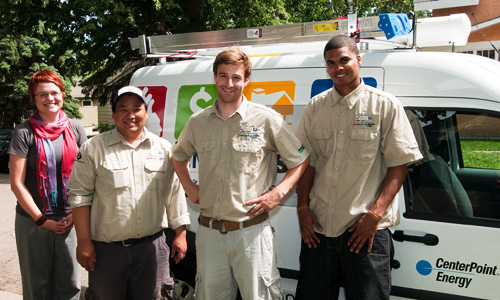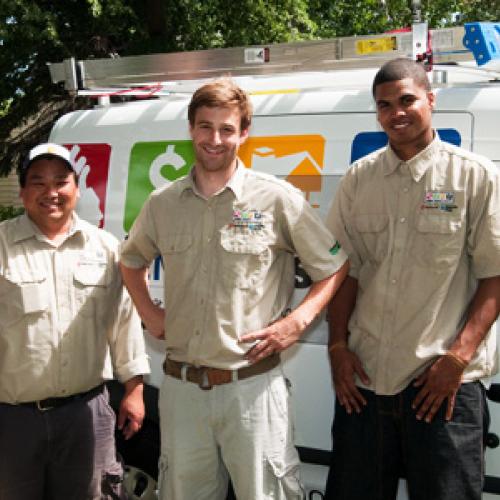In 2009, the Center for Energy and the Environment (CEE) received a grant from the Minnesota Environment and Natural Resources Trust Fund to run a comprehensive neighborhood-based energy efficiency program in eight cities across Minnesota. They contracted with the Metro Clean Energy Resource Teams (Metro CERT) to partner with the Neighborhood Energy Connection (the NEC) to implement the program in the City of Saint Paul. Metro CERT’s role was to recruit participants through community organizing and hold neighborhood workshops to educate residents about energy-saving measures and sign them up for a home visit.
This program was designed to combat the two key shortcoming of existing energy efficiency programming. They are: (1) the low level of implementation of energy-saving actions (found in both residential audits and strictly educational programs) and (2) the low number of participants in most conservation programs. To address poor implementation, the home visit portion of the program consisted mostly of the installation of basic energy saving materials, installed for participants by a trained crew. To address low participation, we utilized community organizing tactics and partnered with the neighborhood organizations to create a grassroots, neighbor-to-neighbor approach.
Program Design
The best predictor of success in recruitment for this program was the quality of the partnership built between Metro CERT and each specific neighborhood in Saint Paul. Neighborhoods with existing organization around environmental issues were more successful in getting the word out and recruiting participants. Likewise, neighborhoods with better infrastructure for organizing (block captains, regular door knocks, effective email lists, etc.) were also more effective. But in addition to infrastructure, the program worked best when Metro CERT had enough time to build a partnership with the neighborhood (as opposed to trying to introduce the program without neighborhood buy-in). Neighborhood buy-in was best achieved through advanced planning, communication, and respecting their priorities and unique circumstances. 
Affluence and “green-ness” of a neighborhood were also decent predictors of participation. Our outreach strategy specifically prioritized outreach to hard-to-reach populations in Saint Paul: the East Side and the Hmong population. We conducted one third of our workshop (17 of 51) in East Side neighborhoods (5 of 17 neighborhoods in Saint Paul), but despite that focus only 22 percent of our participants came from these neighborhoods. In an effort to prioritize outreach to Hmong residents of Saint Paul, the NEC hired a Hmong-speaking Home Energy Squad Crew leader (funded partially with a seed grant from Metro CERT) and two Hmong outreach workers. Through their efforts 56 Hmong homes received a Home Energy Squad visit after participating in workshops given in Hmong. The lesson learned is that tailored efforts result in significantly stronger outcomes and more participants from hard-to-reach populations.
In all neighborhoods we utilized a gamut of recruitment tactics. Participant surveys indicate most participants heard about the program through their District Council, with friends and neighbors sharing information rating as the second most effective way of recruiting participants. Newspapers and media were useful, especially for larger events that drew from a bigger possible pool of participants (i.e. city-wide workshops). Door knocking and door-to-door flier distribution did not produce high yield per hour, but since this tactic was available regardless of other neighborhood infrastructure, it was often a go-to strategy. Door knocking was much more effective when combined with other tactics in the neighborhood (so that door knocking is not the first time a neighbor has heard about the program).
The presentation at the workshop lasted about 1 hour, with 30 minutes of information on behavioral actions, 15 minutes describing the home visit in detail, and 15 minutes for questions. The presentation relied heavily on graphics and pictures in PowerPoint, and anecdotes and stories for content. The goal of the presentation was to entertain while educating, in hopes that material would be better retained if it was enjoyable. The presentation emphasized finding a balance between comfort and efficiency that met each unique situation. Participants were encouraged to focus on changing one or two behaviors, not trying to fix everything possible, so that they would follow through and not be overwhelmed. Immediately after the presentation, participants were asked to sign up for a discounted Home Energy Squad visits from the NEC. Almost all participants who attended the workshop signed up for a home visit.
The home visits took 90 minutes, during which a crew of two to three people did some brief diagnostics of the house (looking at attic insulation, heating systems, and conducting a blower door test) and then spent the majority of the time installing the energy-saving materials. Materials installed include: high-efficiency showerheads, faucet aerators, programmable thermostats, door weather stripping, compact fluorescent bulbs, and an insulating blanket on the water heater. Average annual savings per home, projected from the items installed, ranged from $120-$190. Home visits cost $30 for workshop participants (typically $50 or $80 for the home visit as offered by Xcel Energy and CenterPoint Energy). The price was subsidized with grant funds. Low-income clients received a home visit for free, a benefit arranged by the NEC with outside funds from Xcel Energy’s low-income Conservation Improvement Program.
The grant from the Minnesota Environment and Natural Resources Trust Fund included funding for additional rebates to encourage larger retrofits (furnace or boiler replacement and wall or attic insulation). The program offered a rebate of up to $200 dollars for furnace or boiler replacements and up to $450 for attic or wall insulation starting in the summer of 2010 (the rebate design took longer than anticipated). In order to help homeowners manage the details of separate but complementary rebate programs through this program, the utility and city loan programs, the NEC hired a full-time staff member to work with homeowners considering a larger upgrade. Homeowners found that assistance very useful. Roughly one in three participants actively considered an upgrade, even though most homeowners had at least one opportunity for a larger improvement in their home.
This program was designed to combat the two key shortcoming of existing energy efficiency programming. They are: (1) the low level of implementation of energy-saving actions (found in both residential audits and strictly educational programs) and (2) the low number of participants in most conservation programs. To address poor implementation, the home visit portion of the program consisted mostly of the installation of basic energy saving materials, installed for participants by a trained crew. To address low participation, we utilized community organizing tactics and partnered with the neighborhood organizations to create a grassroots, neighbor-to-neighbor approach.
Program Results
The program delivered excellent results, but not always with equal efficiency. Since the program moved from neighborhood to neighborhood there were significant differences between the effectiveness of outreach in demographically distinct communities. The prerequisite of attending a neighborhood workshop was at times a hindrance towards maximizing the number of home visits, but it also resulted in a higher level of homeowner enthusiasm for the home visit. Neighborhood Energy Service worked with every district council (except the downtown district which is mostly commercial) to host a workshop and recruit neighbors to attend. The program started as an exclusive service for neighbors within a specific district council, and changed after the first nine months into a city-wide program that targeted its recruitment to a specific neighborhood. A total of 55 workshops were held in Saint Paul, in 16 neighborhoods, with some neighborhoods hosting multiple workshops.
Overall, the program was effective at recruiting participants into a residential energy efficiency program. It delivered high quality resident energy efficiency education coupled with measurable and significant implementation rates. Over the 20 months that this program ran—from September 2009 to April 2011—1,592 participants were enrolled at neighborhood workshops. In the 1,470 homes the Home Energy Squad visited, crews installed over 23,000 individual measures, the most common of which were compact fluorescent light bulbs, door weather stripping, faucet aerators and showerheads. In addition, over 2,100 recommendations were made to homeowners asking that they consider a larger retrofit, most commonly attic/wall insulation, air sealing—or less frequently to replace a boiler, furnace or water heater. The total energy saved in the program was 721,145 kilowatt hours of electricity and 136,096 therms of gas. On a per home average that amounts to 490.58 kwh and 92.58 therms, or $141 per year.
For more information about this project, contact: Josh Davis, Home Energy Squad Manager at Neighborhood Energy Connection at [email protected] or 651-328-6220.
Watch a short chapter from ENERGIZED, a CERTs documentary, focused on Neighborhood Energy Services and Home Energy Squad:
Other Local Government Energy Action Community Engagement Stories:
- Stewardship a cornerstone for City on the Lake: White Bear Lake shares sustainability practices
- Elk River provides energy education, outreach and audits with Project Conserve
- How green is your community? A step-by-step Minnesota sustainability program is helping cities
- City of Oakdale takes steps toward sustainability with energy-saving initiatives
- No such thing as the bus rider blues: Linden Hills Power & Light’s Public Transportation Initiative
About the Local Government Energy Action Series:
This year-long effort tells the stories of nearly 50 Minnesota municipalities, counties, and schools and the tangible results of their energy-saving efforts to inspire others to take their own actions.
Local Government Energy Action is brought to you by the Clean Energy Resource Teams (CERTs) in partnership with the Minnesota Department of Commerce, Division of Energy Resources.


